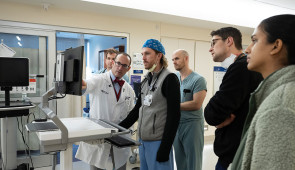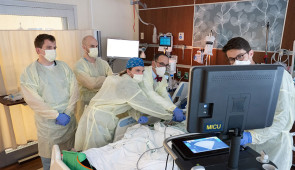- Most commonly reported error in the physical exam is that the exam was never performed
- Report in the New England Journal of Medicine is part of a six-issue series on medical education
- ‘If we don’t intentionally cultivate these bedside skills, they’re at risk of being lost’
CHICAGO --- Today’s doctor visits look and feel a lot different than they did even just a couple decades ago.
Rushed physicians and medical trainees are spending less time with patients, leading to diagnostic errors, poor patient outcomes and increased costs in health care. The influx of AI and other new technology has led to a decline in modern medical trainees’ fundamental bedside skills and a weakening of the doctor-patient relationship. There is a lack of empathy and an increase in physician stress and burnout. The list goes on.
To help reverse these trends, a new report from Northwestern University and the University of Alabama at Birmingham provides six practical strategies to reinvigorate a waning culture of bedside medicine in this new health care environment. The suggestions give clinicians and medical educators guidance on how to better teach and practice important bedside clinical skills, such as the physical exam.
“An appropriate physical exam can help avoid the need for additional diagnostic testing, yet research has shown the most commonly reported error in the physical exam is simply that the exam was never performed,” said corresponding author Dr. Brian Garibaldi, a nationally recognized expert in bedside teaching and the inaugural director of Northwestern University’s new Center for Bedside Medicine.
“Every day, there’s more information coming out about technology and AI, and the more that people use these tools, the more they realize the primary information we get from patients during the history and physical exam is increasingly critical to the decisions we make. There’s only so much tech can do without the correct inputs from humans — both physicians and patients.”
The report will be published Nov. 12 in the New England Journal of Medicine. It is the final issue in the journal’s six-part series on medical education.
“Dedicating part of an education series to these issues underscores the recognition of the value of these skills,” said Garibaldi, the Charles Horace Mayo Professor of medicine in the division of pulmonary and critical care at Northwestern University Feinberg School of Medicine. “If we don’t intentionally cultivate them, they’re at risk of being lost.”
Six ways to reinvigorate the bedside encounter:
- Go to the bedside and observe: Observing a patient from the foot of the bed, or even from the hallway, reveals clues that are critical to understanding a patient’s diagnosis, prognosis and personal circumstances, the report says. For instance, James Parkinson’s description of the “Shaking Palsy” relied almost exclusively on his direct observation of patients. The report notes the modern bedside now includes telemedicine and home health visits, in addition to hospital rooms or outpatient offices. In the preclinical years, students who practice observation in a non-medical context (e.g. by looking at art) can improve observation in the clinical realm.
- Practice and teach an evidence-based approach to the physical exam: Medical students often learn to do physical exams from head to toe, which can lead doctors to rely more on tests and technology than on the exam itself. A better approach is the hypothesis-driven physical exam (HDPE), in which each exam step is chosen based on what the doctor suspects might be wrong using the patient’s history and knowledge of common illnesses to estimate the likelihood of a diagnosis.
- Create opportunities for intentional practice: Patient-centered medical education conducted with learners and teachers at the bedside during rounds can increase efficiency and enhance physician satisfaction. Bedside sessions should start early on in medical school since habits form early and influence a physician’s practice throughout their career. Pre-clinical students who participate in observed bedside clinical encounters with both real and standardized patients have better clinical skills at the end of their third-year clerkships.
- Use technology to teach/reinforce clinical examination skills: AI-enabled bedside medicine is still taking shape, but the results from AI interactions should always inform rather than replace human observation, human clinical decision-making and human communication at the bedside. For instance, point-of-care (or, portable) ultrasound (POCUS) can make diagnoses that elude the traditional physical exam, but the true power of POCUS is that physicians need to be present with patients, strike up a conversation and appropriately uncover the part of the body to be examined.
- Seek and provide feedback on clinical skills: Delivering feedback to learners in the presence of patients is a complex skill, especially if it involves correcting a mistake in exam technique or modifying the diagnosis or treatment plan. Poorly delivered feedback could undermine the relationship between the trainee and patient. But if delivered in a context-specific and thoughtful way, bedside feedback can reassure the patient that the entire team is invested in their care.
- Acknowledge the power of the bedside encounter beyond diagnosis: Uncertainty is a part of bedside patient care, but curiosity — the urge to investigate, to discover — can mitigate uncertainty and help patients, clinicians and trainees to negotiate this uncertainty together, thereby strengthening the patient-physician relationship. Also, the bedside encounter can address health care disparities. A higher percentage of racial and ethnic minority teens reported having never had a physical exam during routine checkups compared to their white peers.
By employing these six strategies, clinical educators can help trainees appreciate the value of the bedside encounter in diagnostic reasoning, strengthen the patient-physician relationship, combat health care inequities, and improve professional fulfillment and burnout, the report said. The words of master clinician educator Sir William Osler ring true over a century later, the report reads: “Medicine is learned by the bedside and not in the classroom. Let not your conceptions of the manifestations of disease come from words heard in the lecture room or read from the book. See, and then reason and compare and control. But see first.”
"From an educational standpoint, the best way to learn about patients is to be with them,” said Dr. Stephen Russell, a physician and professor in the University of Alabama at Birmingham’s division of general internal medicine and population science. “Each of these six steps was crafted under the mindset of finding ways to get doctors out of the conference room and hallways and back to the bedside where their patients are located.”






